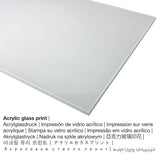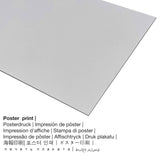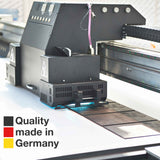Leopold Carl Müller, 1881 - Sugar market - fine art print
Tax included. Shipping calculated at checkout.
Art product explanation
This artwork was made by Leopold Carl Müller. The masterpiece measures the size: 80,5 x 134 cm. Oil on canvas was used by the painter as the technique for the piece of art. It is inscribed with the following information: signed lower right: Leopold Müller. Nowadays, this piece of art is included in the Belvedere's digital collection. We are delighted to reference that the work of art, which belongs to the public domain is provided with courtesy of © Belvedere, Vienna, inventory number: 9515. The creditline of the artpiece is the following: legat Leopold Bauer, Vienna in 1998. Besides, the alignment of the digital reproduction is landscape and has an aspect ratio of 16 : 9, which means that the length is 78% longer than the width. Leopold Carl Müller was a painter, whose style can be classified as Realism. The Realist artist lived for 58 years and was born in the year 1834 in Dresden and passed away in 1892.
Additional information by Belvedere (© - by Belvedere - www.belvedere.at)
The confusion of people, animals, tents u.s.w. is the most picturesque that I have seen in my life wrote Mueller in 1875 from Cairo to Rudolf von Eitelberger. The painter was particularly impressed by the bustle on the various markets, which provided him with numerous ideas and motives. Through the representation of the different "ethnic groups", which differ from each other by color, head shape, hair growth and facial cut, as well as the description of the different costumes he could provide a colorful picture of that country, whose fascination him prisoner since his first visit in 1873 held. This illustration shows a sugarcane market. After sugar cane was grown only in the southern half of the Nile Valley, the sketch was created during or in the wake of Muller's stay in Upper Egypt in January and February 1881st was the center of sugarcane cultivation (and is) Armant, a small town between Luxor and Aswan, so it's possible that the scene plays this city outside the walls. This is a relatively large market which, compared to miller various market representations of Cairo, however, is rural. Here not determine camels appearance, but donkeys are laden with heavy loads. The concentration of those present is focused on buying and selling, as the group of three men standing shows in the foreground, the anecdotal content of the presentation is limited to this gesture. First and foremost is the description of the bustle of the market, without being aware of a spectator pursues his occupation in which everyone involved - of course it also so popular with Müller water water-bearer is not missing. Müller was delighted in Upper Egypt especially the integrity of the population. "I wish you could picturesque brown and black Arabs, Nubians, and Bischaris Barabras see that here in the colorful crowds on the streets hang around" he wrote on 01.05.1881 from Aswan to his sisters. "And the people !!" was it on 28/02/1881 enthusiastically Gherga to Pettenkofen, "Something could be, if one sees the groups in the squares and in the streets." The painter made during his numerous stays Egypt face trials, which he later integrated into the large compositions. He hung up the execution of the heads usually pay more attention than to the design of clothing and ambience which faces often so that the impression of applied photographs arouse (a good example is the elementary school in Upper Egypt, Austrian Gallery Belvedere, Inv No . 4646). The same is also reflected in the present study, where he turned the head of the highest in the middle standing attention, but the environment attributed less importance, indeed sometimes even be contented with suggestive brushstrokes. The comparison with the executed painting, whose whereabouts today is unknown (see Fig. Next to it), shows that Mueller had only transferred the rough composition. Remained the same, the left part of the walls, the standing and squatting group in the foreground, and donkeys. No takeover, however, found the Wasserträgerin and the elegant male Rückenfigur right that has posted their barrels on a set on slopes tabletop. The work has been auctioned in 1892 under the title "market in Cairo" at the estate auction. 1998 The study of the Austrian Gallery Belvedere was handed over as a legacy. Literature: Seligmann, Adalbert Franz (ed.): Carl Leopold Müller. An artist's life in letters, pictures and documents, Vienna, Berlin, Leipzig, Munich 1922; Zemen, Herbert (ed.): Leopold Müller 1834 to 1892. Letters and documents, Vienna 1996; Zemen, Herbert (ed.): Leopold Müller in the artists' house. The Orient images, Vienna 1998. [Sabine Grabner, in: donut, Michael / Mayer, Monika: New Acquisitions Austrian Gallery Belvedere 1992-1999. Master of Heiligenkreuz to Krystufek, ed. v. d. Austrian Gallery Belvedere, Vienna 1999 (temporary exhibition of the Austrian Gallery, 224), pp 68-69]
Work of art specs
| Title of the artpiece: | "Sugar market" |
| Categorization: | painting |
| Category: | modern art |
| Period: | 19th century |
| Artwork year: | 1881 |
| Approximate age of artwork: | over 130 years old |
| Painted on: | oil on canvas |
| Artwork original dimensions: | 80,5 x 134 cm |
| Original artpiece inscription: | signed lower right: Leopold Müller |
| Museum / location: | Belvedere |
| Museum location: | Vienna, Austria |
| Museum's webpage: | www.belvedere.at |
| Artwork license type: | public domain |
| Courtesy of: | © Belvedere, Vienna, inventory number: 9515 |
| Creditline: | legat Leopold Bauer, Vienna in 1998 |
Artist overview table
| Artist: | Leopold Carl Müller |
| Professions: | painter |
| Artist classification: | modern artist |
| Styles of the artist: | Realism |
| Life span: | 58 years |
| Birth year: | 1834 |
| Birthplace: | Dresden |
| Died in the year: | 1892 |
| Died in (place): | Weidlingau near Vienna |
Choose your material
For every art print we offer different sizes & materials. In order match your personal requirements perfectly, you can choose among the following product customization options:
- The canvas print: A canvas print, which should not be confused with a painting on a canvas, is an image printed onto cotton canvas. Further, a canvas print makes a soft, comfy atmosphere. A printed canvas of this artwork will allow you to transform your personal art print into a large work of art as you would see in a gallery. How do I hang a canvas on my wall? Canvas prints are relatively low in weight, which means that it is easy and straightforward to hang up the Canvas print without additional wall-mounts. Because of thata canvas print is suited for any type of wall.
- The poster print (canvas material): The poster is a printed cotton canvas with a granular surface texture. The poster is qualified for framing the art copy using a customized frame. Please keep in mind, that depending on the absolute size of the canvas poster print we add a white margin of approximately 2-6cm round about the work of art, which facilitates the framing with your custom frame.
- Metal print (aluminium dibond): Aluminium Dibond prints are prints on metal with an outstanding depth, which creates a modern look with a surface , that is not reflective. The Direct Print on Aluminum Dibond is your excellent introduction to fine art reproductions with aluminum. For your Direct Print On Aluminum Dibond, we print your selected artpiece right onto the surface of the white-primed aluminum composite.
- Printed acrylic glass with a glossy effect (with real glass coating): The acrylic glass print, often labelled as a print on plexiglass, will convert the original work of art into great wall décor. Further, the acrylic print makes a viable alternative option to aluminium and canvas prints. Your own copy of the work of art is manufactured with modern UV print technology. The great upside of a plexiglass art print is that sharp contrasts and minor image details will be identifiable with the help of the fine gradation.
About this item
| Article type: | fine art print |
| Reproduction method: | reproduction in digital format |
| Production process: | UV direct print (digital printing) |
| Manufacturing: | German-made |
| Type of stock: | production on demand |
| Intended product use: | home design, wall picture |
| Alignment of the artwork: | landscape format |
| Aspect ratio: | 16 : 9 length to width |
| Image ratio meaning: | the length is 78% longer than the width |
| Materials: | acrylic glass print (with real glass coating), poster print (canvas paper), metal print (aluminium dibond), canvas print |
| Canvas print (canvas on stretcher frame) options: | 90x50cm - 35x20", 180x100cm - 71x39" |
| Acrylic glass print (with real glass coating) variants: | 90x50cm - 35x20", 180x100cm - 71x39" |
| Poster print (canvas paper) options: | 90x50cm - 35x20" |
| Dibond print (alumnium material) size options: | 90x50cm - 35x20" |
| Picture frame: | unframed art copy |
Legal disclaimer: We try everythig possible to describe our art products with as many details as possible and to demonstrate them visually on the different product detail pages. Still, the tone of the print products, as well as the printing might differ somehwat from the image on your device's monitor. Depending on your settings of your screen and the quality of the surface, color pigments may not be printed as realisitcally as the digital version on this website. In view of the fact that all the art prints are processed and printed manually, there may also be slight variations in the motif's exact position and the size.
This text is protected by copyright © | www.artprinta.com (Artprinta)














